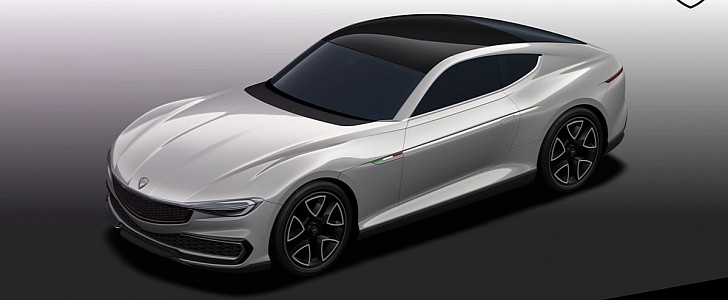As opposed to Italian automakers such as Bizzarrini and Iso, Lancia has survived the 20th and the 21st centuries. A shadow of its former self, the Fiat Chrysler-owned company has been dumbed down into a one-model, one-market affair that pales in comparison to the trailblazing engineering and alluring designs from the olden days.
The Fulvio – a.k.a. Tipo 818 – is one of the models that cemented Lancia’s reputation on the road and in rallying. Named after the Roman road that connects Turin to Tortona, the Fulvia also received a little nip and tuck from Ercole Spada, the man responsible for classics such as the Aston Martin DB4 GT Zagato.
A two-seat fastback officially known as the Sport, the Fulvia with Zagato styling served as the starting point for the HPC and HPE digital concepts. Rendered by surface designer Alberto Salerno of Turin, the three-door coupe and shooting brake feature a sloping roofline, full-width taillights, and a pretty serious aerodynamic diffuser out back.
The sporting theme continues up front with an aggressive yet also restrained fascia, accented by the sculpted hood and elegant headlights. Neither model has side mirrors, meaning that Alberto is advocating for pop-up video cameras and two screens in the A-pillars or front door cards. Speaking of which, Audi, Lexus, and Honda offer digital mirrors in the e-tron quattro crossover, ES sedan, and e city car.
Currently working at the Esiste Group, the surface designer has previously used his skills at Ducati and Pininfarina. Earlier still, the pixel artist responsible for these bite-the-back-of-your-hand beautiful Lancias spent some time at Hyundai Motor Europe, Chinese automaker Chang’an, Lamborghini, Mitsubishi Motors, and Volkswagen.
Despite his effort, Lancia isn’t likely to pick up Salerno’s work as inspiration for an all-new model. “In limbo” encapsulates the Italian automaker’s current state. The introduction of a mild-hybrid powertrain for the Fiat Panda-based Ypsilon is the only newity for 2020, an underwhelming engine compared to the four-cylinder V of the Fulvia.
The V4 is a rare breed in its own right. A handful of bikes feature this engine configuration, and not that long ago, Porsche won the 24 Hours of Le Mans with a turbocharged V4 driving the rear wheels and a motor-generator unit in the front axle of the 919 Hybrid. Last, but certainly not least, the four-cylinder V also serves as an outboard motor for boats thanks to the shorter length compared to an inline-four engine.
A two-seat fastback officially known as the Sport, the Fulvia with Zagato styling served as the starting point for the HPC and HPE digital concepts. Rendered by surface designer Alberto Salerno of Turin, the three-door coupe and shooting brake feature a sloping roofline, full-width taillights, and a pretty serious aerodynamic diffuser out back.
The sporting theme continues up front with an aggressive yet also restrained fascia, accented by the sculpted hood and elegant headlights. Neither model has side mirrors, meaning that Alberto is advocating for pop-up video cameras and two screens in the A-pillars or front door cards. Speaking of which, Audi, Lexus, and Honda offer digital mirrors in the e-tron quattro crossover, ES sedan, and e city car.
Currently working at the Esiste Group, the surface designer has previously used his skills at Ducati and Pininfarina. Earlier still, the pixel artist responsible for these bite-the-back-of-your-hand beautiful Lancias spent some time at Hyundai Motor Europe, Chinese automaker Chang’an, Lamborghini, Mitsubishi Motors, and Volkswagen.
Despite his effort, Lancia isn’t likely to pick up Salerno’s work as inspiration for an all-new model. “In limbo” encapsulates the Italian automaker’s current state. The introduction of a mild-hybrid powertrain for the Fiat Panda-based Ypsilon is the only newity for 2020, an underwhelming engine compared to the four-cylinder V of the Fulvia.
The V4 is a rare breed in its own right. A handful of bikes feature this engine configuration, and not that long ago, Porsche won the 24 Hours of Le Mans with a turbocharged V4 driving the rear wheels and a motor-generator unit in the front axle of the 919 Hybrid. Last, but certainly not least, the four-cylinder V also serves as an outboard motor for boats thanks to the shorter length compared to an inline-four engine.


















